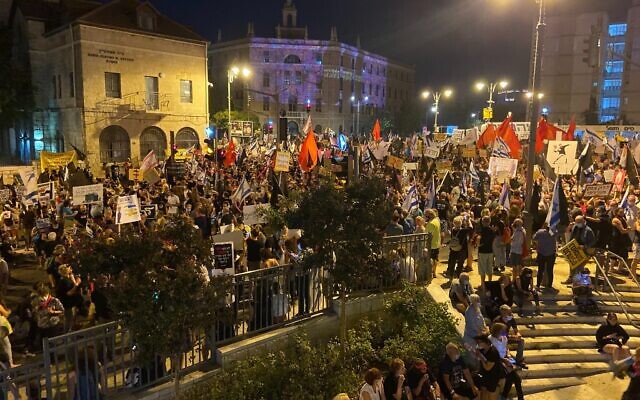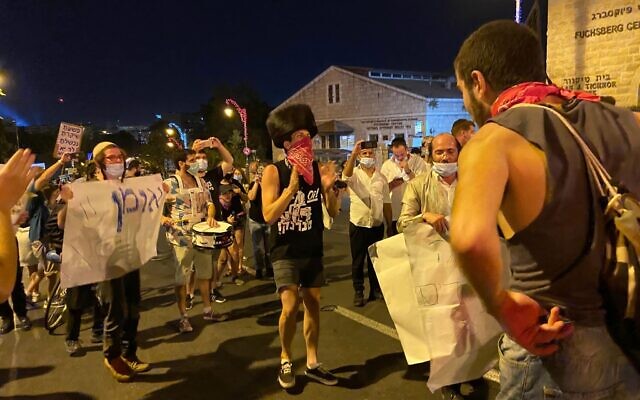A week after facing public outcry for ostensibly heavy-handed tactics, police in Jerusalem were noticeably restrained as they faced off against government protesters outside the Prime Minister’s Residence in the capital on Saturday night.
The event was estimated to have drawn 20,000 participants, according to Israeli media reports, while organizers, who handed out bracelets to keep track of attendance, put the figure at 37,000. It was the largest demonstration yet against Prime Minister Benjamin Netanyahu by protesters who are calling on him to resign due to his ongoing corruption trial and the government’s handling of the coronavirus outbreak.
Police said 16 people were detained or arrested for disturbing public order or assaulting policemen. Several people received fines for blocking roads after police called on demonstrators to disperse at midnight. The previous weekend 30 people were arrested during scuffles.
Saturday’s protest began with an unapproved march by thousands from the Chords Bridge at the city entrance to Paris Square, where the main demonstration took place yards from the prime minister’s official residence on Balfour Street.
Around 9:45 p.m., when the marchers arrived at Paris Square they stood outside a fenced-off protest area and shouted to the police “Take down the barricades.” Protesters inside the barricaded area joined the chanting and banged on the metal barriers, as high-ranking police officials observed the scene from a balcony above.
After around 15 minutes, police gave into the protesters’ demands and removed the barriers, allowing the thousands of marchers to join the crowd inside. Protesters responded with applause for the police.
It was the first time the police had agreed to remove the barricades despite previous requests by demonstrators who said they feel trapped and unable to social distance as required during the pandemic. Police had previously insisted that the barricades were essential for protesters’ safety.

Protesters next to metal barricades during a demonstration against Prime Minister Benjamin Netanyahu outside his official residence, August 29, 2020. (Anat Peled/Times of Israel)
“The moment they saw the masses they moved aside and just let us walk,” said lawyer Gonen Ben Yitzhak, who took part in the march. Ben Yitzhak is one of the leaders of Crime Minister, a core organizing group behind the protest.
According to Ben-Yitzhak, one of the reasons for Jerusalem police’s more restrained behavior yesterday was Thursday’s march in Tel Aviv which, although unapproved, ended quietly. Protesters commended Tel Aviv police officers’ ability to contain the protest without using violence.
This “forced them [the Jerusalem Police] to a certain level of behavior so that they would prove to everyone that they are okay,” Ben Yitzhak told The Times of Israel.
The crowd largely appeared to abide by police orders to stop making noise with drums and whistles at 9:30 p.m. and to stop using speakers and megaphones at 11 p.m.
Unlike the previous Saturday, police did not attempt to disperse the crowds at 11 p.m. when they sought to reopen the roads, but instead let the protesters quietly remain in the square until around midnight. Although the officers repeatedly asked the crowd to clear the way because street was opening to traffic, hundreds of protesters remained seated on the ground, blocking passage until the end.
Around 12:45 a.m., police were forced to clear the protesters, one by one, from Paris Square. However, unlike on previous occasions when demonstrators were immediately dragged aside, officers could be seen reasoning with protesters and asking them politely to get up on their own, then escorting them as they moved away. When this did not work, they carried protesters out but refrained from dragging and pushing as they have done in late-night dispersals at previous protests.

Demonstrators against Prime Minister Benjamin Netanyahu outside his official residence in Jerusalem on August 29, 2020. (Olivier Fitoussi/Flash90)
“In the army they always drill into us that you have to be a personal example to your subordinates… If he [Netanyahu] were in the army right now he would quit because this is how it is supposed to be,” said 27-year-old Dor Levy from Kibbutz Afikim in the north of Israel.
It was Levy’s first time at the Balfour protest. He had decided to drive over in search of something more “meaningful” after earlier participating in a weekly protest at the Tzemach Junction just south of the Sea of Galilee. Levy said he found the protest much less chaotic than he had expected.
During the course of the evening, special interest demonstrators gathered in groups to advocate for their issues. In one corner a group of women decried sexual violence and rape. In another corner Bratslav Hasidim gathered to cry for Uman — the Ukrainian pilgrimage site which will remain off-limits this Rosh Hashanah. And yet in another corner, Ethiopian youth chanted against police brutality.
Three Ethiopian teens repeatedly gathered a crowd around them and called out the names of people killed by the police. A group of nearby officers who were observing the protest watched quietly, apparently listening.
Uman worshipers join anti-corruption activists
While many of those participating in the demonstrations were secular, left-leaning Israelis, an unusual feature of Saturday night’s demonstration was the arrival of around 200 members of the Bratslav Hasidic sect who are upset that the government has banned their annual Rosh Hashanah pilgrimage to visit the grave of their venerated Rabbi Nachman in Uman, Ukraine. The group carried signs such as “Netanyahu is against Rabbi Nachman” and “Netanyahu you have lost our votes.”
Shema, a 68-year-old Bratslav Hasid and self-declared religious right-winger said he was at the protest “because of Uman” and would continue to come to Paris Square until travel would be allowed to the pilgrimage site.
“It is not fair, they let people travel to a lot of places and there are a lot of people in Eilat, every hotel is packed, also in Greece,” he told The Times of Israel.

Bratslav Hasidim join protesters during a demonstration against Prime Minister’s Benjamin Netanyahu outside his official residence, August 29, 2020. Hebrew sign to left reads ‘Uman.’ (Anat Peled/Times of Israel)
The Bratslav protesters were greeted with cheers by the other demonstrators. In one corner, a group of Bratslav Hasidim could be seen dancing with some secular young men who tried on their big furry black hats, or shtreimels.
According to Ben Yitzhak, part of what makes the Balfour demonstrations different from other protests is their ability to bring together protesters from different groups.
“We do the things together and march together and each person shouts the slogans of the other and when sitting in circles everyone talks to each other…In my eyes it is a very beautiful thing. I think that for a long time we were unsuccessful in connecting [between people] and here you see that everyone is connecting and…learning about the causes of other people,” he said.
“At the end we are fighting for a better society, a new society and if we are able to do this here, in my opinion there is a chance that it will ultimately happen on the national level.”
Related posts:
Views: 0
 RSS Feed
RSS Feed

















 August 30th, 2020
August 30th, 2020  Awake Goy
Awake Goy  Posted in
Posted in  Tags:
Tags: 
















